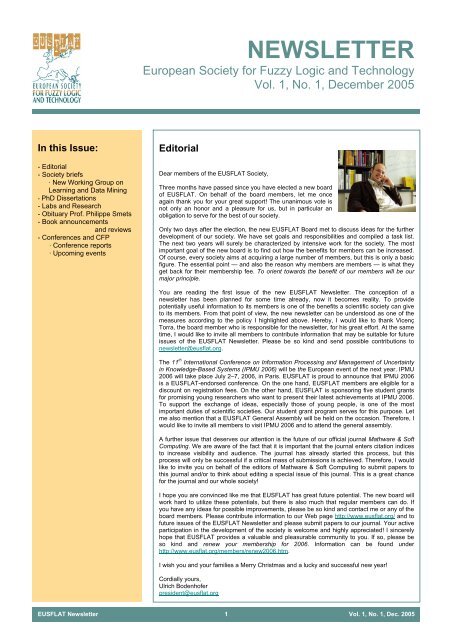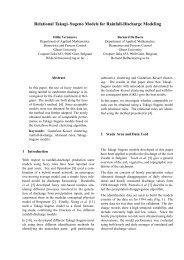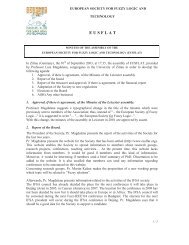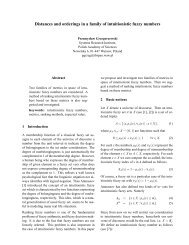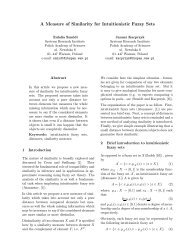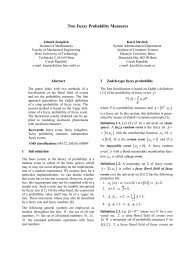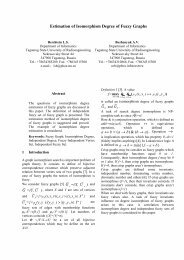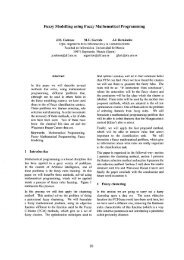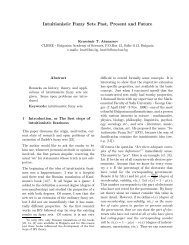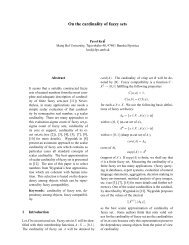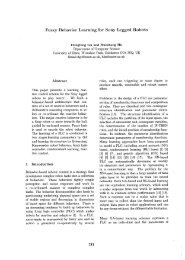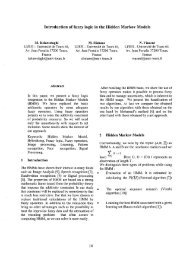Vol. 1, No. 1, December 2005 - EUSFLAT
Vol. 1, No. 1, December 2005 - EUSFLAT
Vol. 1, No. 1, December 2005 - EUSFLAT
Create successful ePaper yourself
Turn your PDF publications into a flip-book with our unique Google optimized e-Paper software.
In this Issue:<br />
- Editorial<br />
- Society briefs<br />
· New Working Group on<br />
Learning and Data Mining<br />
- PhD Dissertations<br />
- Labs and Research<br />
- Obituary Prof. Philippe Smets<br />
- Book announcements<br />
and reviews<br />
- Conferences and CFP<br />
· Conference reports<br />
· Upcoming events<br />
NEWSLETTER<br />
European Society for Fuzzy Logic and Technology<br />
<strong>Vol</strong>. 1, <strong>No</strong>. 1, <strong>December</strong> <strong>2005</strong><br />
Editorial<br />
Dear members of the <strong>EUSFLAT</strong> Society,<br />
Three months have passed since you have elected a new board<br />
of <strong>EUSFLAT</strong>. On behalf of the board members, let me once<br />
again thank you for your great support! The unanimous vote is<br />
not only an honor and a pleasure for us, but in particular an<br />
obligation to serve for the best of our society.<br />
Only two days after the election, the new <strong>EUSFLAT</strong> Board met to discuss ideas for the further<br />
development of our society. We have set goals and responsibilities and compiled a task list.<br />
The next two years will surely be characterized by intensive work for the society. The most<br />
important goal of the new board is to find out how the benefits for members can be increased.<br />
Of course, every society aims at acquiring a large number of members, but this is only a basic<br />
figure. The essential point — and also the reason why members are members — is what they<br />
get back for their membership fee. To orient towards the benefit of our members will be our<br />
major principle.<br />
You are reading the first issue of the new <strong>EUSFLAT</strong> Newsletter. The conception of a<br />
newsletter has been planned for some time already, now it becomes reality. To provide<br />
potentially useful information to its members is one of the benefits a scientific society can give<br />
to its members. From that point of view, the new newsletter can be understood as one of the<br />
measures according to the policy I highlighted above. Hereby, I would like to thank Vicenç<br />
Torra, the board member who is responsible for the newsletter, for his great effort. At the same<br />
time, I would like to invite all members to contribute information that may be suitable for future<br />
issues of the <strong>EUSFLAT</strong> Newsletter. Please be so kind and send possible contributions to<br />
newsletter@eusflat.org.<br />
The 11 th International Conference on Information Processing and Management of Uncertainty<br />
in Knowledge-Based Systems (IPMU 2006) will be the European event of the next year. IPMU<br />
2006 will take place July 2–7, 2006, in Paris. <strong>EUSFLAT</strong> is proud to announce that IPMU 2006<br />
is a <strong>EUSFLAT</strong>-endorsed conference. On the one hand, <strong>EUSFLAT</strong> members are eligible for a<br />
discount on registration fees. On the other hand, <strong>EUSFLAT</strong> is sponsoring five student grants<br />
for promising young researchers who want to present their latest achievements at IPMU 2006.<br />
To support the exchange of ideas, especially those of young people, is one of the most<br />
important duties of scientific societies. Our student grant program serves for this purpose. Let<br />
me also mention that a <strong>EUSFLAT</strong> General Assembly will be held on the occasion. Therefore, I<br />
would like to invite all members to visit IPMU 2006 and to attend the general assembly.<br />
A further issue that deserves our attention is the future of our official journal Mathware & Soft<br />
Computing. We are aware of the fact that it is important that the journal enters citation indices<br />
to increase visibility and audience. The journal has already started this process, but this<br />
process will only be successful if a critical mass of submissions is achieved. Therefore, I would<br />
like to invite you on behalf of the editors of Mathware & Soft Computing to submit papers to<br />
this journal and/or to think about editing a special issue of this journal. This is a great chance<br />
for the journal and our whole society!<br />
I hope you are convinced like me that <strong>EUSFLAT</strong> has great future potential. The new board will<br />
work hard to utilize these potentials, but there is also much that regular members can do. If<br />
you have any ideas for possible improvements, please be so kind and contact me or any of the<br />
board members. Please contribute information to our Web page http://www.eusflat.org/ and to<br />
future issues of the <strong>EUSFLAT</strong> Newsletter and please submit papers to our journal. Your active<br />
participation in the development of the society is welcome and highly appreciated! I sincerely<br />
hope that <strong>EUSFLAT</strong> provides a valuable and pleasurable community to you. If so, please be<br />
so kind and renew your membership for 2006. Information can be found under<br />
http://www.eusflat.org/members/renew2006.htm.<br />
I wish you and your families a Merry Christmas and a lucky and successful new year!<br />
Cordially yours,<br />
Ulrich Bodenhofer<br />
president@eusflat.org<br />
<strong>EUSFLAT</strong> Newsletter 1 <strong>Vol</strong>. 1, <strong>No</strong>. 1, Dec. <strong>2005</strong>
Society briefs:<br />
New Working Group on Learning and Data Mining<br />
<strong>EUSFLAT</strong> provides an organizational framework for research on specific subfields of fuzzy set theory in the form of Working Groups, covering<br />
topics such as Aggregation Operators, Decision Analysis, Fuzzy Control, Generalized Measures, Neuro-Fuzzy Systems, and Operations<br />
Research.<br />
Motivated by the increased interest that topics in the field of learning from data and data mining have attracted within the fuzzy set community in<br />
recent years, a new working group on "Learning and Data Mining" (DAMI) has been established in <strong>2005</strong>. The goal of this working group is to<br />
promote research in the field of fuzzy machine learning and data mining. Moreover, DAMI shall provide a forum for discussions on this topic and<br />
a repository for resources on fuzzy data mining, including software and benchmark data sets, amongst other things. As its first activity, DAMI<br />
has organized a special session at the Eusflat-LFA <strong>2005</strong> conference in Barcelona.<br />
DAMI is coordinated by Professor Eyke Hüllermeier (University of Magdeburg, Germany, huellerm@iti.cs.uni-magdeburg.de) and Professor<br />
Frank Klawonn (University of Applied Sciences BS/WF Wolfenbuettel, Germany, f.klawonn@fh-wolfenbuettel.de). A link to the website of the<br />
working group can be found at www.eusflat.org/research/. Please feel free to contact one of the coordinators for any further information.<br />
PhD Dissertations:<br />
Mario Drobics<br />
Data Analysis using Fuzzy Expressions — Creating Comprehensible Computational Models from Data<br />
Abstract: Technical and economic processes are getting constantly more complex. Analytical models are often insufficient to describe and<br />
handle this complexity. Data accumulations, on the other hand, are growing at ever increasing speeds, providing a potential source of<br />
knowledge and experience to understand and manage these processes.<br />
This work is therefore concerned with the general problem of creating comprehensible computational models from data. To derive such models<br />
from data, various different methods like statistical regression, artificial neural nets, and other data-mining based approaches exist. Typically,<br />
however, the resulting models are either comprehensible (e.g. rule based approaches) or accurate (e.g. neural nets), referring a tough decision<br />
to the user. As in real world applications often both aspects are of high importance, the need for methods providing comprehensible and<br />
accurate models arises.<br />
In this work a novel approach which uses fuzzy predicates to create close-to natural language expressions describing the relations in the data<br />
under investigation is presented. These expressions are not only easily comprehensible, but can be used for classification and numerical<br />
prediction tasks as well. A further application of the proposed methods is the characterization of general patterns in the data (e.g. clusters) using<br />
linguistic expressions.<br />
First, the theoretical foundations of fuzzy set theory which are necessary to create comprehensible computational models are presented. By<br />
defining a general language based on fuzzy predicates, a flexible framework for defining fuzzy logic based models is provided.<br />
Then, different aspects related to data preprocessing and data cleaning which are of special importance when dealing with real world data sets<br />
are discussed. Special emphasis is placed on the automatic definition of meaningful fuzzy predicates.<br />
In the main section of the work three different kinds of inductive learning, namely classification, regression learning, and creating linguistic<br />
descriptions, are investigated. Four novel methods for deriving computational models from a given set of samples are presented and it is shown<br />
how these methods can be applied to the different types of learning problems.<br />
Finally, the generality of the proposed approach is illustrated by different examples. The work is closed with a comparison study, including other<br />
well known algorithms.<br />
The concepts and methods described in this work have been successfully applied in a number of real world projects and are available within the<br />
machine learning framework for Mathematica which has been mainly developed by the author.<br />
About the Author: Dr. Mario Drobics, born in 1973, studied applied mathematics at the Vienna University of Technology and Johannes Kepler<br />
University Linz, where he received his PhD degree in <strong>2005</strong>. The author is currently area manager for knowledge-based technologies at the<br />
Software Competence Center Hagenberg.<br />
Bibliographic Information:<br />
M. Drobics. Data Analysis using Fuzzy Expressions — Creating Comprehensible Computational Models from Data. <strong>Vol</strong>. C 48 of Schriftenreihe<br />
der Johannes Kepler Universität Linz. Universitätsverlag Rudolf Trauner, Linz, 2006. ISBN 3-85487-932-6.<br />
Labs and Research:<br />
Rules, inferences and robust approximation in the<br />
Institute for Research and Applications of Fuzzy Modeling<br />
Antonín Dvořák, Vilém <strong>No</strong>vák and Irina Perfilieva<br />
University of Ostrava, IRAFM, 30. dubna 22, 701 03 Ostrava, Czech Republic<br />
The Institute for Research and Applications of Fuzzy Modeling (IRAFM) is a scientific place of work belonging to the University of Ostrava in<br />
Ostrava, Czech Republic, whose aim is both theoretical research as well as applications of fuzzy logic, fuzzy approximation and other<br />
disciplines belonging to the area of soft computing. The latter can be characterized as the scientific theory whose aim is to develop theories and<br />
methods which might effectively work in the presence of indeterminacy (i.e. imprecision and uncertainty) and provide practically optimal and<br />
<strong>EUSFLAT</strong> Newsletter 2 <strong>Vol</strong>. 1, <strong>No</strong>. 1, Dec. <strong>2005</strong>
inexpensive solutions in situations where only rough, imprecise information (very often expressed in natural language) is at disposal.<br />
Applications in cooperation with industry have also been realized.<br />
In this article, we present two of few main lines of research in our institute, namely a study of the, so-called, linguistic descriptions and properties<br />
of inferences over them (this research is conducted by V. <strong>No</strong>vák, A. Dvořák, V. Pavliska, M. Holčapek and P. Murinová), and a study of various<br />
methods and aspects of approximation of functions using fuzzy sets and fuzzy algebras (this research conducted by I. Perfilieva, M. Daňková.<br />
M. Štěpnička, R. Valášek, L. <strong>No</strong>sková, O. Polakovič and D. Plšková). Both lines are founded by the theory of fuzzy logic which is another main<br />
line of our research.<br />
Linguistic description is in our conception a set of fuzzy IF-THEN rules taken as genuine linguistic expressions. We model these rules by means<br />
of formal fuzzy logic with strong emphasis on proper linguistic treatment of expressions contained in them (V. <strong>No</strong>vák, A. Dvořák.). This is<br />
accomplished by means of :<br />
• careful study of expressions like small, more or less high, approximately 26, etc., which we call evaluating linguistic expressions. These<br />
expressions play a central role in important part of natural language and human inference based on it.<br />
• interpreting of IF…THEN structure of rules as linguistically expressed logical implications. We provide mathematical description of them in<br />
the frame of higher-order fuzzy logic.<br />
This methodology allows us to hide the inner machinery from the user. He/she can communicate with computer on the level of (restricted)<br />
natural language without necessity to access and modify meanings of the used expressions. Computer then acts (performs inferences) in a way<br />
close to human so that the computer can be taken as a specific “human partner”. Our software system LFLC (Linguistic Fuzzy Logic Controller,<br />
developed by V. <strong>No</strong>vák, A. Dvořák, V. Pavliska) is primarily dedicated to design and testing of linguistic descriptions, and realizes logical<br />
deduction on the basis of them. We have implemented a large-scale application of our method in Kovohutě Břidličná, where LFLC controls five<br />
massive aluminium furnaces. It uses linguistic descriptions obtained from persons with experience with control of these furnaces. At present,<br />
modeling and simulation is performed via interface to MATLAB/Simulink.<br />
We have also developed special methods of learning linguistic information from large data sets. Possible applications of our methods are very<br />
wide and cover pure fuzzy control, classification, human-like decision making, expert forecasting, complex human language based reasoning,<br />
and others.<br />
A specific and promising field of application is search for the, so-called, linguistic associations in numerical data. ur approach (V. <strong>No</strong>vák, A.<br />
Dvořák), however, provides consistent treatment of vague notions naturally included in them. Moreover, we are using methods and concepts<br />
originally developed in the GUHA method. Important and successful objective of our research can be called fuzzy approximation. This is a class<br />
of methods for approximation of classical functions using techniques of soft computing. The methods inherited all the advantages of robust<br />
models based on fuzzy IF-THEN rules.<br />
Fuzzy approximating models, in general, can be divided into two classes: methods based on normal forms of logical functions (I. Perfilieva, M.<br />
Daňková), and methods produced by the inverse fuzzy transform (I. Perfilieva, M. Štěpnička). <strong>No</strong>rmal forms are special logical formulas<br />
stemming from formal representations of fuzzy IF-THEN rules that can be used for representation of a large class of approximating functions.<br />
Together with optimization criteria, they provide with a good representation of any extensional function.<br />
The technique of fuzzy transforms (F-transforms) can be considered as a generalization of the well known Fourier and wavelet transforms and<br />
can be used in a solution of a number of application oriented problems. Among them, we may announce new numerical methods for solution of<br />
ordinary and partial differential equations, computation of definite integrals, methods for data compression and reconstruction, filtering of signals<br />
and last, but not least, fusion of images. All these methods are very robust that is, they are little sensitive to changes of input data.<br />
Our research institute is a carrier of the Research Plan „Logical and algebraic methods for elaboration of information subjected to indeterminacy<br />
and their use in fuzzy modeling” of the Ministry of Education of the Czech Republic and a partner of the Research Centre DAR<br />
(Data/Algorithms/Decision Making).<br />
Links: IRAFM institute: http://irafm.osu.cz/irafm<br />
LFLC software (demo available): http://irafm.osu.cz/irafm/lflc/<br />
Prof. Philippe Smets Deceased<br />
Professor Philippe Smets passed away on Monday night <strong>No</strong>vember the 14th, at home with his family around. He had been suffering from a<br />
brain tumor for several months. For those interested in uncertainty modeling and handling, he was an outstanding researcher in this area, in<br />
some sense a guiding light.<br />
Philippe Smets was born in Brussels (Belgium) on <strong>No</strong>vember 27, 1938. He first received a medical doctor degree in 1963 from the Université<br />
Libre de Bruxelles (ULB), then a Master degree in experimental statistics from <strong>No</strong>rth Carolina State University, and his PhD degree in medical<br />
statistics from ULB in 1978. This PhD dissertation, the starting point of his research work, already contained in germ many of the ideas on belief<br />
functions that Philippe Smets was going to develop in the next two decades. Philippe Smets was the founder in 1985 of the IRIDIA laboratory<br />
(Institut de Recherches Interdisciplinaires et de Développements en Intelligence Artificielle) at ULB, and its director until he retired in 1999. He<br />
then had more time to develop his own research works, visiting different academic institutions, and cooperating with many colleagues in the<br />
world.<br />
His name is primarily associated with the «Transferable Belief Model» (TBM), an original view of Shafer’s theory of evidence. He had met<br />
Shafer in the seventies during his stay in the US. In the TBM, the credal level, where beliefs are entertained, is carefully distinguished from the<br />
decision level where standard utility theory applies. He contributed more than 100 papers on this approach. Among his key technical<br />
contributions, let us particularly mention the axiomatic justifications for the Dempster rule of combination, or for the pignistic transform that<br />
relates the credal and the decision levels, as well as algorithmic tools for the easy computational handling of belief functions. See the reference<br />
list below. But his scientific contribution is much broader.<br />
Indeed Philippe Smets was instrumental in the development of the research community dealing with uncertainty in artificial intelligence. He was<br />
indeed the main coordinator and the prime contractor of a series of European workshops or projects (DRUMS – I & II), that gathered many<br />
researchers working on different uncertainty approaches. These projects resulted in a series of edited volumes on <strong>No</strong>n-Standard Logics for<br />
Automated Reasoning (with A. Mamdani, D. Dubois and H. Prade), on Uncertainty Management in Information Systems (with A. Motro), on<br />
Defeasible Reasoning and Uncertainty Management Systems (a Handbook series in 7 volumes, with D. Gabbay), or on special issues of<br />
Journals on Uncertainty, Conditionals and <strong>No</strong>n-Monotonicity, or on Data and Knowledge Fusion. Philippe Smets is also the father of the<br />
European Conference on Symbolic and Quantitative Approaches to Reasoning with Uncertainty (ECSQARU), which has taken place every two<br />
<strong>EUSFLAT</strong> Newsletter 3 <strong>Vol</strong>. 1, <strong>No</strong>. 1, Dec. <strong>2005</strong>
years since 1991. He was also an active participant of the annual Uncertainty in Artificial Intelligence (UAI) Conference in the nineties and was<br />
the first European UAI co-program chair in 1991. He served on the editorial boards of many journals including the International Journal of<br />
Approximate Reasoning, the Journal of Logic and Computation, Information Sciences, Fuzzy Sets and Systems, the IEEE Transactions on<br />
Fuzzy Systems, the International Journal of Uncertainty, Fuzziness and Knowledge-Based Systems, the Journal of Applied <strong>No</strong>n Classical<br />
Logics, and Mathware and Soft Computing.<br />
Although his main research focus was on belief functions, he also wrote noticeable papers in fuzzy logic and possibility theory. His first<br />
conference paper in 1978 relates belief functions and fuzzy sets, and was the basis for his definition of the degree of belief in a fuzzy event<br />
based on a Choquet integral. Later with Paul Magrez, he provided an original axiomatic justification of Lukasiewicz implication in the setting of<br />
fuzzy if-then rule-based reasoning. He also very early (in 1982!) pointed out connections between likelihood functions and possibility measures,<br />
and recently (in 2002) provided the basis for an operational semantics of quantitative possibility theory.<br />
Philippe Smets was a highly recognized and respected researcher in the Artificial Intelligence community. Its innovative work on the treatment of<br />
belief functions is well known and appreciated by everyone in the field. He was primarily a researcher combining a vast culture and interest on<br />
classical and non-classical approaches to uncertainty, with a will to develop original lines of research that significantly depart from traditional<br />
views. For any of his colleagues, and us in particular (we met him for the first time in Lyon, at the CNRS Round Table on Fuzzy Sets, on June<br />
23-25, 1980), he was much more than that, he was the friend, the careful adviser, the companion of so many beautiful research projects.<br />
Thanks to his keen work, his open-mindedness and his great human qualities, he had succeeded in creating and federating a whole community<br />
of researchers in Europe, through a series of projects and conferences of which he had been the principal carrier. His illness and his death<br />
whereas he was still in full creative activity were for us, for all his friends and colleagues, a terrible shock that leaves us all like orphans. He will<br />
be deeply missed for a long time.<br />
Didier Dubois and Henri Prade<br />
IRIT, Toulouse, Dec. <strong>2005</strong><br />
Main References<br />
Edited <strong>Vol</strong>umes<br />
Philippe Smets, Abe Mamdani, Didier Dubois, Henri Prade, (eds.) <strong>No</strong>n-Standard Logics for Automated Reasoning, Academic Press, New<br />
York,1988.<br />
Michael R. B. Clarke, Christine Froidevaux, Eric Grégoire, Philippe Smets (eds.) Uncertainty, Conditionals and <strong>No</strong>n-Monotonicity. Positions and<br />
Debates in <strong>No</strong>n-Standard Logics. Special issue of the J. of Applied <strong>No</strong>n-Classical Logics, 1 (2): 103-310 (1991).<br />
Bruce D'Ambrosio, Philippe Smets, Piero P. Bonissone (eds.) Proceedings of the Seventh Annual Conference on Uncertainty in Artificial<br />
Intelligence (UAI '91), July 13-15, 1991, University of California at Los Angeles, Los Angeles, CA, USA Morgan Kaufmann 1991<br />
Philippe Smets, Ami Motro, (eds.) Uncertainty Management in Information Systems: From Needs to Solutions, Kluwer Academic Publ., 1998.<br />
Philippe Smets (ed.) Quantified Representation of Uncertainty and Imprecision. <strong>Vol</strong>. 1 of the Handbook of Defeasible Reasoning and<br />
Uncertainty Management Systems (D. M. Gabbay, P. Smets, eds.), Kluwer Acad. Publ., 1998.<br />
Dov M. Gabbay, Philippe Smets (series eds.) Handbook of Defeasible Reasoning and Uncertainty Management Systems, Kluwer Acad. Publ., 7<br />
vol. (1998-2002).<br />
Transferable Belief Model<br />
Philippe Smets: Un modèle mathématico-statistique simulant le processus du diagnostic médical, PhD Thesis, 1978. Available by Univ.<br />
Microfilm, Ann Harbor, Michigan.<br />
Philippe Smets: Belief functions. In <strong>No</strong>n-Standard Logics for Automated Reasoning, (P. Smets, A. Mamdani, D. Dubois, H. Prade, eds.),<br />
Academic Press, New York, 1988, 253-286.<br />
Philippe Smets: Constructing the pignistic probability function in a context of uncertainty. Uncertainty in Artificial Intelligence 5, (M. Henrion, R.<br />
D. Shachter, L. N. Kanal, and J. F. Lemmer, eds.) (UAI 1989), <strong>No</strong>rth Holland, Amsterdam, 1990, 29-40.<br />
Philippe Smets: The transferable belief model and other interpretations of Dempster-Shafer's model. Proc. of the Sixth Annual Conf. on<br />
Uncertainty in Artificial Intelligence (UAI 1990), 375-384.<br />
Philippe Smets: The combination of evidence in the Transferable Belief Model. IEEE Trans. Pattern Analysis and Machine Intelligence 12(5):<br />
447-458 (1990)<br />
Philippe Smets: Varieties of ignorance and the need for well-founded theories. Information Sciences, 57-58: 135-144 (1991)<br />
Philippe Smets: Probability of provability and belief functions. Logique et Analyse, 133-134: 177-195 (1991)<br />
Frank Klawonn, Philippe Smets: The dynamic of belief in the Transferable Belief Model and specialization-generalization matrices. Proc. of the<br />
Eigth Annual Conference on Uncertainty in Artificial Intelligence (UAI '92): 130-137<br />
Philippe Smets: Resolving misunderstandings about belief functions. Int. J. Approx. Reasoning, 6 (3): 321-344 (1992)<br />
Hung T. Nguyen, Philippe Smets: On dynamics of cautious belief and conditional objects. Int. J. Approx. Reasoning, 8(2): 89-104 (1993)<br />
Philippe Smets: Belief functions: The disjunctive rule of combination and the generalized Bayesian theorem. Int. J. Approx. Reasoning, 9 (1): 1-<br />
35 (1993)<br />
Philippe Smets, Robert Kennes: The Transferable Belief Model. Artificial Intelligence, 66 (2): 191-234 (1994)<br />
Philippe Smets: The canonical decomposition of a weighted belief. Proc. of the 14th Inter. Joint Conf. on Artificial Intelligence (IJCAI-95).<br />
Montréal, August 20-25, 1995, 1896-1901<br />
Didier Dubois, Henri Prade, Philippe Smets: Representing partial ignorance. IEEE Trans. on Systems, Man and Cybernetics, 26(3): 361-377<br />
(1996)<br />
Philippe Smets: The normative representation of quantified beliefs by belief functions. Artificial Intelligence, 92 (1-2): 229-242 (1997)<br />
Philippe Smets: The transferable belief model for quantified belief representation. In Quantified Representation of Uncertainty and Imprecision.<br />
<strong>Vol</strong>. 1 of the Handbook of Defeasible Reasoning and Uncertainty Management Systems (D. M. Gabbay, P. Smets, eds.), Kluwer Acad. Publ.,<br />
267-301 (1998)<br />
Salem Benferhat, Alessandro Saffiotti, Philippe Smets: Belief functions and default reasoning. Artificial Intelligence, 122 (1-2): 1-69 (2000)<br />
Roger M. Cooke, Philippe Smets: Self-conditional probabilities and probabilistic interpretations of belief functions. Ann. Math. Artificial<br />
Intelligence, 32 (1-4): 269-285 (2001)<br />
Zied Elouedi, Khaled Mellouli, Philippe Smets: Belief decision trees: theoretical foundations. Int. J. Approx. Reasoning, 28 (2-3): 91-124 (2001)<br />
André Ayoun, Philippe Smets: Data association in multi-target detection using the transferable belief model. Int. J. Intelligent Systems, 16 (10):<br />
1167-1182 (2001)<br />
Boutheina Ben Yaghlane, Philippe Smets, Khaled Mellouli: Belief function independence: I. The marginal case. Int. J. Approx. Reasoning, 29<br />
(1): 47-70 (2002)<br />
Philippe Smets: The application of the matrix calculus to belief functions. Int. J. Approx. Reasoning, 31 (1-2): 1-30 (2002)<br />
Boutheina Ben Yaghlane, Philippe Smets, Khaled Mellouli: Belief function independence: II. The conditional case. Int. J. Approx. Reasoning, 31<br />
(1-2): 31-75 (2002)<br />
Philippe Smets: Decision making in the TBM: the necessity of the pignistic transformation. Int. J. Approx. Reasoning, 38 (2): 133-147 (<strong>2005</strong>).<br />
Philippe Smets: Belief functions on real numbers. Int. J. Approx. Reasoning, 40 (3): 181-223 (<strong>2005</strong>).<br />
Fuzzy logic contributions<br />
<strong>EUSFLAT</strong> Newsletter 4 <strong>Vol</strong>. 1, <strong>No</strong>. 1, Dec. <strong>2005</strong>
Philippe Smets: Medical diagnosis: Fuzzy sets and degree of belief (9p.) Actes Colloque International sur la Théorie et les Applications des<br />
Sous-Ensembles Flous, <strong>Vol</strong>. II, Marseille, 20-24 Sept. 1978. Final version in Fuzzy Sets and Systems, 5, 259-266, 1981.<br />
Philippe Smets: Philippe Smets: Possibilistic inference from statistical data. Proc. 2nd World Conf. on Mathematics at the Service of Man, Las<br />
Palmas (Canary Islands), Spain, (A. Ballester, D. Cardus, E. Trillas, eds.), June 28-July 3, 1982, 611-613<br />
Philippe Smets: The degree of belief in a fuzzy event. Information Sciences, 25(1): 1-19 (1981)<br />
Philippe Smets, Paul Magrez: Implication in fuzzy logic. Int. J. Approx. Reasoning, 1(4): 327-347 (1987)<br />
Philippe Smets, Paul Magrez: The measure of the degree of truth and of the grade of membership. Fuzzy Sets and Systems, 25 (1988) 67-72.<br />
Paul Magrez, Philippe Smets: Epistemic necessity, possibility, and truth. Tools for dealing with imprecision and uncertainty in fuzzy knowledgebased<br />
systems. Int. J. Approx. Reasoning, 3(1): 35-57 (1989)<br />
Paul Magrez, Philippe Smets: Fuzzy modus ponens: a new model suitable for applications in knowledge-based systems. Int. J. Intelligent<br />
Systems, 4 (1989) 181-200.<br />
Philippe Smets: Quantified epistemic possibility theory seen as a hyper cautious transferable belief model. Actes Rencontres Francophones sur<br />
la Logique Floue et ses Applications, La Rochelle, 18-20 Octobre 2000, Cépaduès, Toulouse, 343-353.<br />
Didier Dubois, Henri Prade, Philippe Smets: New semantics for quantitative possibility theory. Proc. 6th.Europ. Conf. on Symb. and Quantitat.<br />
Appr. to Reasoning under Uncertainty (ECSQARU 2001), Toulouse,19-21 sept., Springer-Verlag, LNAI n°2143, 410-421, 2001.<br />
Didier Dubois, Henri Prade, Philippe Smets: "<strong>No</strong>t Impossible" vs. "Guaranteed Possible" in Fusion and Revision. Proc. 6th.Europ. Conf. on<br />
Symb. and Quantitat. Appr. to Reasoning under Uncertainty (ECSQARU 2001), Toulouse,19-21 sept., Springer-Verlag, LNAI n°2143, 522-<br />
531, 2001.<br />
Didier Dubois, Henri Prade, Philippe Smets. A definition of subjective possibility. Operations Research and Decisions (Wroclaw) n°4, 2003, 7-<br />
22.<br />
Book announcements and reviews:<br />
- E.P. Klement, R. Mesiar (Eds.) Logical, Algebraic, Analytic and Probabilistic Aspects of Triangular <strong>No</strong>rms, Elsevier, <strong>2005</strong>. 492 pages.<br />
ISBN 0-444-51814-2.<br />
Conferences and Call for Papers<br />
Conference reports:<br />
Upcoming <strong>EUSFLAT</strong>-Endorsed Events:<br />
- 8th International Conference on Fuzzy Set Theory and Applications (FSTA 2006), Liptovský Mikuláš, Slovak Republic, January 30 -<br />
February 3, 2006.<br />
http://www.valm.sk/fsta/<br />
- 27th Linz Seminar on Fuzzy Set Theory (LINZ2006), Linz, Austria, February 7-11, 2006.<br />
http://www.flll.jku.at/research/linz2006/index.html<br />
- 3rd International Conference on Modeling Decisions for Artificial Intelligence (MDAI 2006), Tarragona, Catalonia, Spain, April 3-5,<br />
2006.<br />
http://www.mdai.info/mdai2006/<br />
- 8th International Conference on Artificial Intelligence and Soft Computing (ICAISC 2006), Zakopane, Poland, June 25-29, 2006.<br />
http://icaisc.pcz.pl/<br />
- 11th International Conference on Information Processing and Management of Uncertainty in Knowledge-Based Systems (IPMU<br />
2006), Paris, France, July 2-7, 2006. Submission deadline: <strong>December</strong> 20, <strong>2005</strong>.<br />
http://ipmu2006.lip6.fr/<br />
- 2nd International Symposium on Evolving Fuzzy Systems (EFS '06), Lake District, UK, September 7-9, 2006. Submission deadline:<br />
February 1, 2006.<br />
http://www.efs06.org/<br />
- 9th Fuzzy Days, Dortmund, Germany, September 18-20, 2006. Submission deadline: January 31, 2006.<br />
http://www.efs06.org/<br />
Other Events:<br />
- SAC 2006 - Special Track on Information Access and Retrieval (SAC-IAR 2006), Dijon, France, April 23-27, 2006.<br />
http://www.cis.strath.ac.uk/external/SAC2006/<br />
- 7th International Conference on Flexible Query Answering Systems (FQAS 2006), Milano, Italy, June 7-10, 2006. Submission<br />
deadline: February 15, 2006.<br />
http://fqas2006.disco.unimib.it/<br />
- 2006 IEEE World Congress on Computational Intelligence, Vancouver, BC, Canada, July 16-21, 2006. Submission deadline:<br />
January 31, 2006.<br />
http://www.wcci2006.org/<br />
- 3rd IEEE Conference On Intelligent Systems, London, U.K., September 4-6, 2006. Submission deadline: <strong>December</strong> 12, <strong>2005</strong>.<br />
http://ieeeis06.wmin.ac.uk<br />
<strong>EUSFLAT</strong> Board<br />
President: Ulrich Bodenhofer<br />
Vice-President: Lluís Godo<br />
Secretary: Irina Perfilieva<br />
Treasurer: Oscar Cordón<br />
Web: Ulrich Bodenhofer<br />
Mathware and Soft Computing: Juan Luís Castro<br />
Grants and prizes: Bernard de Baets<br />
Working groups: Eyke Hüllermeier<br />
Newsletter editor: Vicenç Torra<br />
http://www.eusflat.org/<br />
http://www.eusflat.org/publications/newsletter.htm<br />
e-mail: newsletter@eusflat.org<br />
<strong>EUSFLAT</strong> Newsletter 5 <strong>Vol</strong>. 1, <strong>No</strong>. 1, Dec. <strong>2005</strong>


